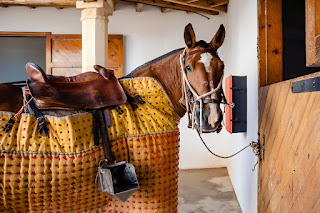How to Transport Your Horse Safely ?
Transporting a horse safely is a task that requires careful planning, attention to detail, and knowledge of best practices. Whether you’re traveling a short distance to a nearby stable or embarking on a long journey to a competition, ensuring your horse’s safety and comfort is paramount. Here are comprehensive guidelines to help you transport your horse safely.
1. Preparing for the Journey
a. Choose the Right Transport Vehicle
- Horse Trailer or Horsebox: Ensure the trailer or horsebox is appropriately sized for your horse, allowing them to stand comfortably without being cramped.
- Inspection: Regularly inspect the transport vehicle for structural integrity, proper flooring, and secure partitions.
- Ventilation: Adequate ventilation is crucial to prevent overheating or respiratory issues.
b. Plan Your Route
- Opt for the smoothest and most direct route to minimize stress on your horse.
- Avoid roads with excessive traffic or sharp turns that might cause instability.
c. Paperwork and Documentation
- Carry the horse’s health certificate, vaccination records, and any required permits, especially for interstate or international travel.
2. Preparing Your Horse
a. Familiarize Your Horse with the Trailer
- Desensitization: Gradually introduce your horse to the trailer. Let them explore it and practice loading and unloading.
- Positive Reinforcement: Reward calm behavior with treats or verbal praise to create a positive association.
b. Ensure Your Horse is Fit for Travel
- Schedule a veterinary check-up to confirm your horse is healthy and fit for the journey.
- Avoid transporting horses with injuries or illnesses unless absolutely necessary and under veterinary guidance.
c. Feeding and Hydration
- Feed your horse a light meal several hours before departure.
- Ensure they are well-hydrated, and offer water breaks every few hours during long trips.
3. Loading and Securing Your Horse
a. Safe Loading Practices
- Use a well-maintained ramp with non-slip surfaces.
- Lead your horse calmly and steadily into the trailer. Avoid rushing or forcing them.
b. Proper Securing
- Use appropriate halters and ties to secure your horse. Ensure the ties allow some movement but prevent the horse from turning around or moving excessively.
- Check that all partitions and dividers are secure and provide enough space for your horse to balance during the ride.
4. During the Journey
a. Drive Carefully
- Avoid sudden stops, sharp turns, or rapid acceleration.
- Maintain a steady speed and check the condition of the road frequently.
b. Monitor Your Horse
- Use a monitoring system or occasionally stop to check on your horse’s condition.
- Look for signs of stress, such as excessive sweating, restlessness, or labored breathing.
c. Rest Stops
- For long journeys, plan regular rest stops to allow your horse to relax, drink water, and stretch their legs if feasible.
5. After the Journey
a. Unloading Safely
- Unload your horse calmly and methodically. Avoid sudden movements that could startle them.
- Allow them to acclimate to their new environment before engaging in any activities.
b. Post-Travel Care
- Check your horse for any signs of injury, dehydration, or stress.
- Provide them with fresh water, food, and a clean, comfortable space to rest.
c. Reflect on the Trip
- Evaluate what went well and identify areas for improvement in future trips.
Additional Tips for Safe Horse Transport
- Travel Insurance: Consider travel insurance for your horse to cover unexpected incidents.
- Travel Companions: Horses often feel calmer when traveling with a familiar companion. If possible, transport them with another horse.
- Emergency Kit: Carry a well-stocked emergency kit that includes first-aid supplies, extra halters, ropes, and tools for minor trailer repairs.
Conclusion
Transporting your horse safely requires preparation, patience, and vigilance. By prioritizing your horse’s comfort and well-being, you can ensure a smooth and stress-free journey. With proper planning and adherence to these best practices, you can make every trip a safe and pleasant experience for both you and your horse.

